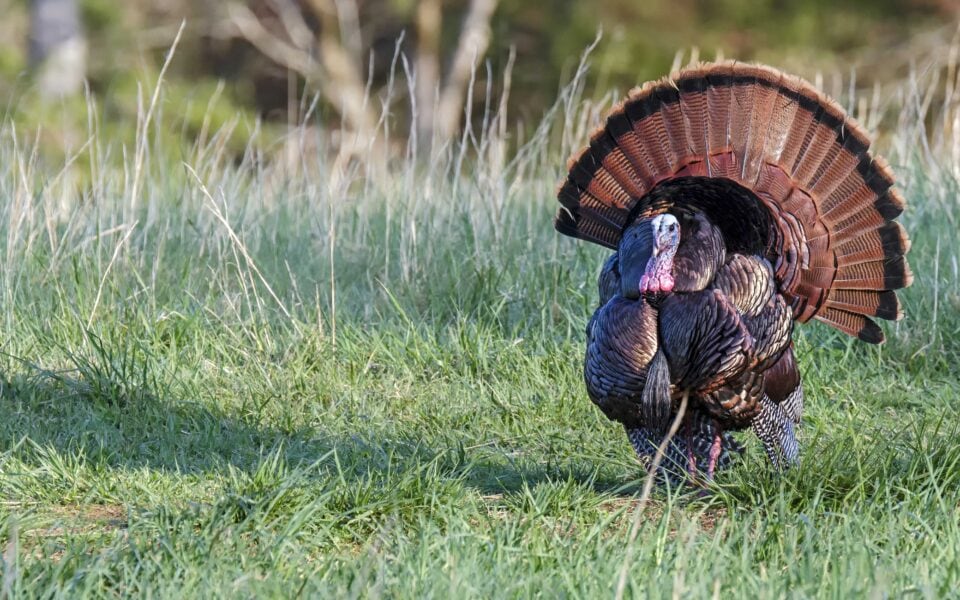There’s no doubt that a major reason why turkey hunting is so popular and somewhat addicting, is the fact that the bird’s great senses and instincts can challenge even the most seasoned hunters, and no two hunts are the same. While we’ll never be able to control the weather or the attitudes of the birds we love to pursue, gamekeepers can better understand natural and manmade draws for wild turkeys – the kind they are attracted to regardless of the conditions or their “feelings.” While Mother Nature provides natural funnels and sustenance, if you really want to improve your chances of success you need to think like a hungry turkey; become a little “bird-brained.”
Identifying food sources and habitat features that draw turkeys is part of the process of “thinking like a turkey.” Turkeys dine on a variety of foods in varying locations. If you can identify what the turkeys in your region crave at that time, then you greatly enhance your chances of success. By improving the area’s food choices and their consistent availability, you better your chances exponentially. Creating good bugging habitat and nest cover to enhance poult development and survival are also on the gamekeepers’ “to-do list.” Identifying natural travel routes and creating dusting areas is also important, especially when hunting season comes.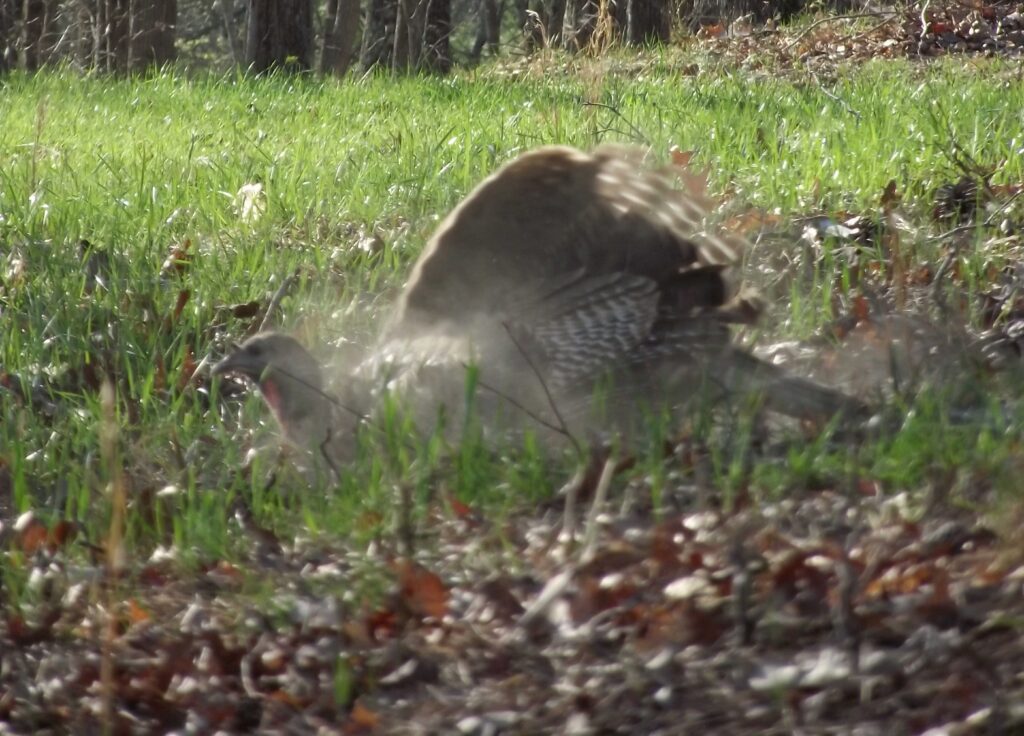
Food Sources
Depending on your region, wild turkeys have different natural masts on which to feed. No matter if you have the greatest stand of timber in your state, weather conditions and plant cycles can either enhance or prohibit natural mast production. During years when acorn, beechnut, and other nuts are abundant you can bet your birds will hang close to those natural food sources in the fall and winter or until they’re gone. Thinning competing trees near white oaks and other important mast-producing trees will allow their canopy to enlarge and will improve nut production.
Tending to the timber is important, however, don’t forget that the most exhilarating hunts occur during the spring when the toms are gobbling and natural food is sometimes lean. Fall planting of an annual grass for spring setups is one way to make your land work in your favor.
In the southern half of the turkey’s range, a grand choice is winter wheat. If you plant your winter wheat in September or October, it will mature by the time your spring season rolls around. The seed heads will develop after the winter months and you’ll find large numbers of hens and toms frequenting your plots. The seed heads can also remain after the poults begin hatching and provide excellent cover and sustenance for them throughout their most vulnerable days.
If your plot is large and you need shooting lanes then you can mow strips through the wheat to scatter seed and create opportunities for you to place your shot. Winter wheat can also be planted in the spring which will allow the seed heads to develop just in time for your fall and winter turkey seasons. In some cases, you may be able to plow under your old winter wheat plot and replant for the fall season.
In more northern climes, perennial legumes, which we’ll talk about next, would be the first choice of many. But if you want any type of a grain crop, it will have to make it through the winter. And by “make it through” it doesn’t mean while “growing and alive,” it means to make it without being devoured already or by having deteriorated so far it can’t even be considered food. Corn is a possibility…again if there’s anything left after winter. Chufa, grown in abundance (again, enough to more than satisfy the local wildlife needs), can become “locked” in the ground over the winter, but then become a valuable food source when thawed in the spring. Sorghum and some other grasses can also provide seeds, the question in the north is, was there enough to make it through the winter so there’s still sufficient available to call it a draw.
Aside from annual crops, you can also plant perennial crops such as clover to create year-round feeding. Bottomland and woodland plots can create travel corridors that will quickly become your turkeys’ favorite highway. These small woodland plots become the stage for some amazing turkey socialization and ultimately for awesome hunting setups.
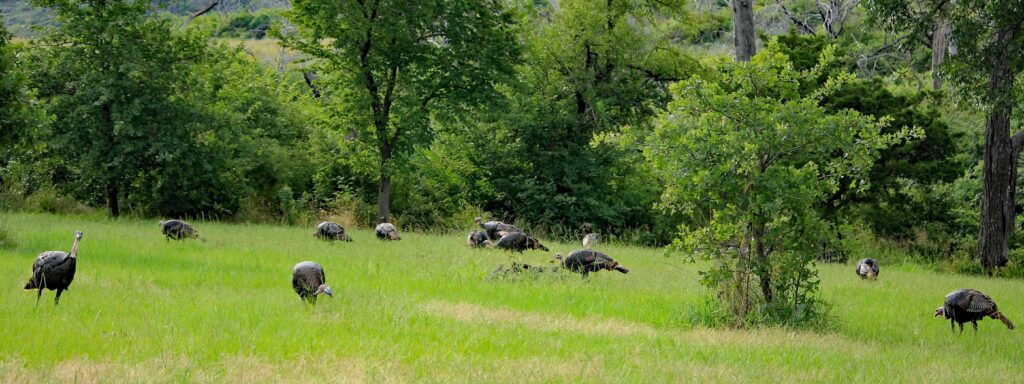 Turkeys tend to move quickly from one place to another, but having these small plots placed throughout your farm will slow them down as they feed on tender foliage. These perennial plots also make excellent bugging habitats.
Turkeys tend to move quickly from one place to another, but having these small plots placed throughout your farm will slow them down as they feed on tender foliage. These perennial plots also make excellent bugging habitats.
If you are limited to the amount of available land for plots you can resort to sowing seed on existing log roads and landings. The plants will stabilize the soil and become an instant draw for your birds. During peak breeding season the toms will use your roadways frequently to cover ground quickly and for strutting zones as they search for receptive hens.
Perhaps the most cost-effective enhancement you can add to your property for turkeys is creating bugging habitat. Simply allowing areas to become overgrown with native weeds and grasses will attract insects and will ultimately invite turkeys to feed. Grasshoppers and other insects are a favorite delicacy for turkey poults and are imperative for their survival. Creating good bugging habitat is also a cheap and sure-fire way to attract and keep wild turkeys on your property.
Aside from providing food, the native weeds and grasses provide cover for the poults as they feed. Much like a staging area that deer hunters refer to, bugging habitat along plot edges gives the turkeys a place to pause and scope out the area before they emerge.
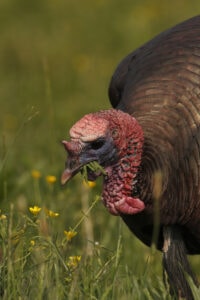 If your land has standing timber you can create perfect nesting areas for hens by cutting some of the timber and leaving the treetops where they fall. Predation of nests can be a real problem for hens that don’t have good cover in which to nest. Small areas of 2-3 acres of dense cover can mean the difference between success and failure of a turkey nest and will directly affect the future of turkey hunting on your farm.
If your land has standing timber you can create perfect nesting areas for hens by cutting some of the timber and leaving the treetops where they fall. Predation of nests can be a real problem for hens that don’t have good cover in which to nest. Small areas of 2-3 acres of dense cover can mean the difference between success and failure of a turkey nest and will directly affect the future of turkey hunting on your farm.
Creation of Turkey Hangouts
Gamekeepers need to study the birds and understand the value of effective scouting. Ideally, anticipating the wild turkey’s every move means success in the field. Understanding what turkeys want and then what your farm offers, or lacks, will help you discover ways to enhance your turkey habitat. Since turkeys prefer to travel in large numbers during much of the year, creating “social” areas for them to congregate makes sense if such areas don’t already exist.
Amidst a turkey’s daily routines is the event of “dusting.” Turkeys love to find areas where the soil is exceptionally loose where they can lie down kick up dust. These areas are hotspots for congregating flocks. Adding additional known turkey draws to the immediate area adds to the attraction-power and means turkeys will spend more time at the spot.
The turkeys scratch the ground and then fluff their feathers as they kick up dust. It is believed that they do this to relieve the irritation of mites and fleas. Areas along log roads or beneath pine stands are great locations to find a dusting area. You can however create a dusting area with a tractor or ATV.
Simply plowing or disking small strips along natural travel corridors will provide loose soil where the turkeys can then do their dusting. Placing your hunting blinds within shooting range of a dusting site can greatly increase your odds of scoring a tom. Even in times when the toms are locked up with the hens, they’ll many times be drawn to the area as they court their dusting dolls.
If you’ve ever harvested a wild turkey and examined its crop and gizzard, you likely discovered that they consume gravel and grit to help digest grains and other hard foods. Much like dusting areas, turkeys will typically spend some time each day in an area where they can consume grit.
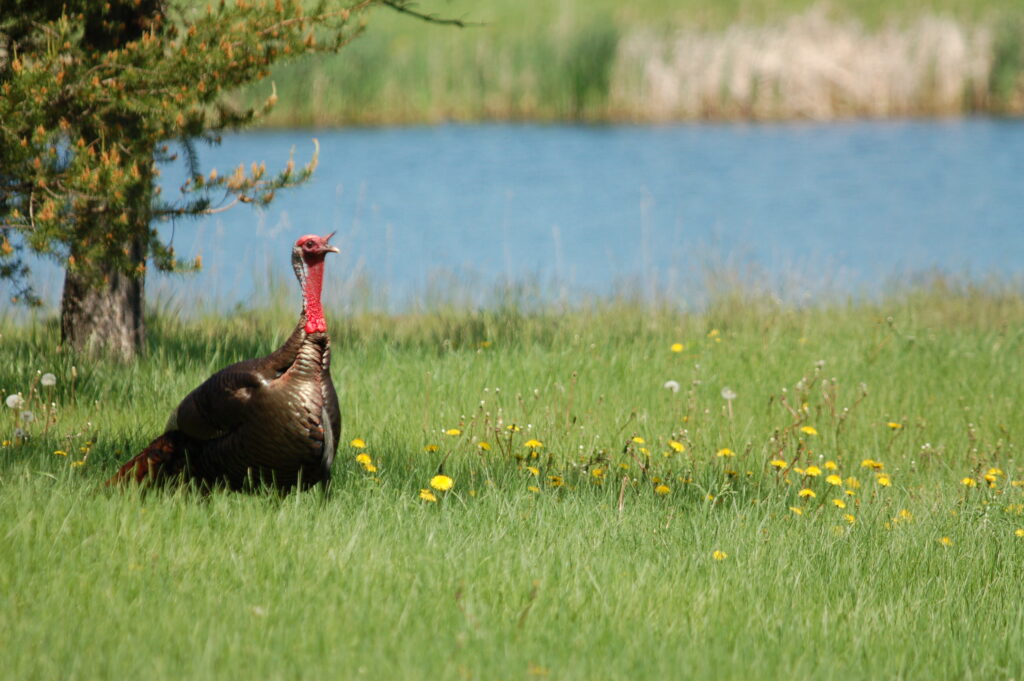 If your area is primarily forested where gravel and grit are scarce, you can even create your own grit or sand area for the turkeys by simply dumping small loads of the material near frequented areas. Obviously, commercial turkey grit used in poultry farming is an easy way to remedy the lack of grit. Otherwise, if you have a river or creek, oftentimes grit can be found along the bank. Grit is an essential need of all turkeys (and other birds).
If your area is primarily forested where gravel and grit are scarce, you can even create your own grit or sand area for the turkeys by simply dumping small loads of the material near frequented areas. Obviously, commercial turkey grit used in poultry farming is an easy way to remedy the lack of grit. Otherwise, if you have a river or creek, oftentimes grit can be found along the bank. Grit is an essential need of all turkeys (and other birds).
We’re simply trying to provide for as many of the wild turkeys’ needs as possible at a given spot. If you add dependable food and a reliable water source, now we’re talking about a turkey paradise. Having a couple of acres close where you can rotate some “turkey favorites,” means again, they will spend more time at the spot. We talked about some preferred food plot crops above, but you could add beech, hickory, and pine trees along with juniper, dogwood, wild cherry, crabapple, grapes, and berries as some natural foods that can also be added to the landscape.
Adding certain grass plantings can provide for billions of seeds, excellent bugging habitat, and great nesting and escape cover. Native warm-season grasses can be difficult to establish and care for in some areas, but even annual grasses like sorghum, numerous varieties of millet, oats, wheat, or even corn all produce foods that turkeys love.
Turkeys can go without some other needs, but they cannot go for long without water. If you do not have a creek or pond in the vicinity, a stock tank buried in a low spot, or better yet, a Banks water system can work wonders. You want a source that will be available day-in or day-out so the birds imprint on that element and its dependability.
Funneling Turkeys
It’s often discussed in deer hunting forums about how hunters can use diversions to direct or funnel deer toward particular areas. Turkeys can be directed in the same fashion. If you are hunting along a food plot you can use brush piles along the perimeter to create entrance and exit points.
It doesn’t take a lot of money, but it takes time and effort to place brush as barriers along the edges of the plot. Hinge cutting small trees and allowing part of the tree to remain intact with the stump will allow the leaves to continue on living and actually create a living barrier. Turkeys will get hung up along something as simple as a fence and certainly have no desire to pass through a thicket if there is a clear alternate route. Like most critter’s out there, they take the path of least resistance.
As planting, felling trees, and arranging brush piles can restrict movement, we can also make it easier for their travel by mowing, or cutting trails by other means. It’s probably best if somehow you enhance a route where the birds already prefer to travel rather than attempting to force them in a particular direction. It’s pretty simple, once again we’re talking about the easiest route will usually be taken.
Remember, hunting is referred to as a sport because it is competitive and many times your success is relative to your preparation. Fortunately, some of the ways that a gamekeeper can enhance turkey habitat are actually low-cost but they can have an immediate and lasting impact on your property’s appeal for wild turkeys.

